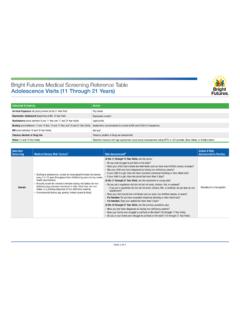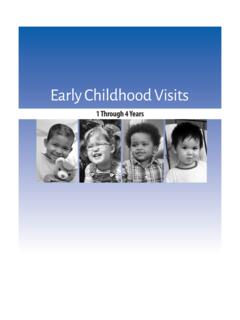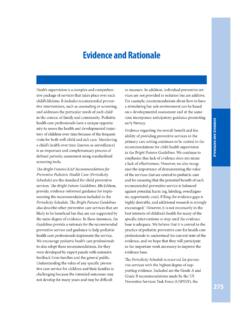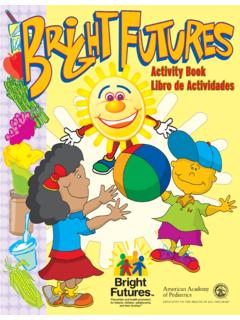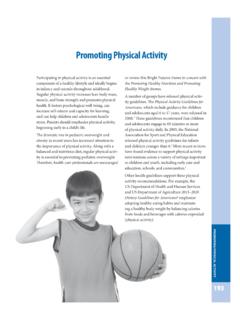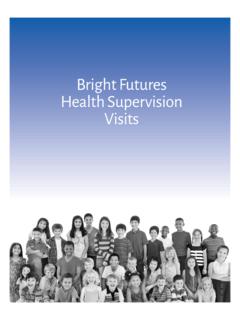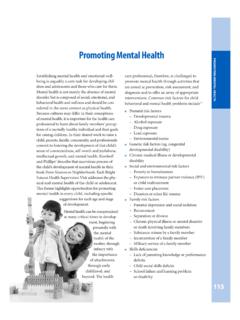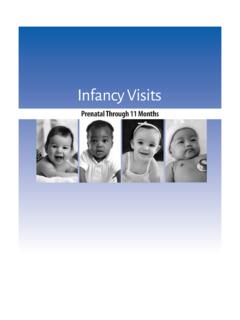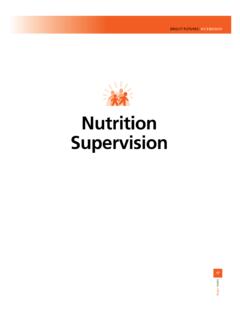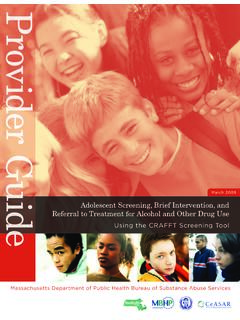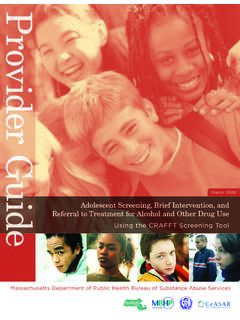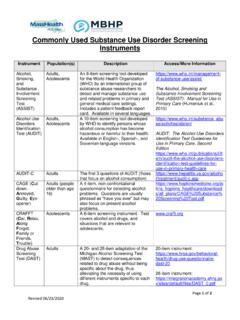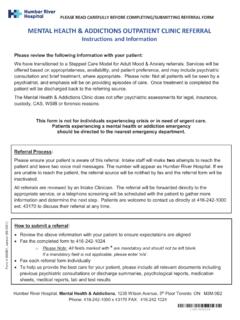Transcription of ADOLESCENT ALCOHOL AND SUBSTANCE USE AND ABUSE
1 Why Is It Important to Screen for ADOLESCENT ALCOHOL and SUBSTANCE Use? ALCOHOL and SUBSTANCE use is associated with deaths, injuries, and health problems among US teenagers. Use is associated with leading causes of death, including unintentional injuries (eg, motor vehicle crashes), homicides, and suicides. More than 30% of all deaths from injuries can be directly linked to ALCOHOL . SUBSTANCE use also is associated with a wide range of non-lethal but serious health problems, including school failure, respiratory diseases, and high-risk sexual behaviors. ALCOHOL and SUBSTANCE use is common among adolescents. Studies show that 46% of adolescents have tried ALCOHOL by eighth grade, and by senior year in high school 77% of adolescents have begun to drink. Moreover, 20% of eighth graders and 58% of seniors have been drunk. Adolescents have recently reported increasing misuse of prescription drugs, including psychostimulant medications and oral opioid factors can predict increases in the prevalence of use of specific illicit drugs.
2 An increase in the perceived availability of the drug A decrease in the perceived risk of harm associated with use of the drugMisuse of ALCOHOL and drugs is found among all demographic subgroups. Higher risk of misuse is associated with being male, white, and from middle to upper socioeconomic status families. 103 ADOLESCENT ALCOHOL AND SUBSTANCE USE AND ABUSESCREENINGE arly age of first use of ALCOHOL and drugs can increase the risk of developing a SUBSTANCE use disorder during later life. Recurrent drunkenness, recurrent cannabis use, or any use of drugs other than cannabis are not normative behaviors, and health care practitioners should always consider them serious risks. However, experimentation with ALCOHOL or cannabis or getting drunk once can arguably be considered developmentally normative behaviors. When Should You Evaluate an ADOLESCENT s ALCOHOL or SUBSTANCE Use?
3 SUBSTANCE use should be evaluated as part of an age-appropriate comprehensive history. Reviewing the ADOLESCENT s environment can identify risk and protective factors for the development of ALCOHOL or drug ABUSE . Risk Factors A family history of SUBSTANCE ABUSE or mood disorders. One in 5 children grows up in a household where someone abuses ALCOHOL or other drugs. SUBSTANCE use by a family member is associated with higher rates of SUBSTANCE use in adolescents. Poor parental supervision and household disruption are associated with involvement in SUBSTANCE use and other risk behaviors. Low academic achievement and/or academic aspirations. Untreated attention-deficit disorder (ADD) and attention-deficit/hyperactivity disorder (ADHD). JOHN KNIGHT, MDTIMOTHY ROBERTS, MD, MPHJOY GABRIELLI, MDSHARI vAN HOOK, MPHPERFORMING PREVENTIVE SERVICES: A BRIGHT FUTURES HANDBOOK104 PERFORMING PREVENTIVE SERVICESADOLESCENT ALCOHOL AND SUBSTANCE USE AND ABUSE Perceived peer acceptance of SUBSTANCE use and SUBSTANCE use in Factors Parents who set clear rules and enforce them.
4 Eating meals together as a family. Parents who regularly talk with their children about the dangers of ALCOHOL and drug use. Having a parent in recovery. Involvement in church, synagogue, or community programs. Opportunities for prosocial involvement in the community, adequate community Should You Evaluate an ADOLESCENT s ALCOHOL or SUBSTANCE Use?Use Informal Methods Ask about ALCOHOL and SUBSTANCE use. Many adolescents do not discuss their SUBSTANCE use with their physician. The most common reason given for not discussing SUBSTANCE use during a clinic visit was never being asked. Evidence shows that 65% of adolescents report a desire to discuss SUBSTANCE use during clinic visits. Begin with open-ended questions about SUBSTANCE use at home and school and by peers before progressing to open-ended questions about personal use. Two questions that can readily screen for the need to ask further questions include Have you ever had an alcoholic drink?
5 Have you ever used marijuana or any other drug to get high?1 Recognize the importance and complexity of confidentiality issues. Providing a place where the ADOLESCENT can speak confidentially is associated with greater disclosure of risk behavior involvement. Time alone with the physician during the clinic visit is associated with greater disclosure of sensitive the same time, the confidentiality of your conversation is limited by an ADOLESCENT s reports of threat to self, threat to others, and ABUSE . After reviewing the severity of an ADOLESCENT s SUBSTANCE use, you can judge the seriousness of a threat to self. Discuss the need to disclose sensitive information with the ADOLESCENT before disclosing to parents or other people (treatment specialists, for example).Use screening ToolsThe evidence supporting screening for SUBSTANCE misuse in adolescents is Type IV (Expert Opinion) because no clinical trials support the efficacy of screening during clinical encounters.
6 However, several tools are available, and the CRAFFT screener (Boxes 1 and 2) has high sensitivities and specificities for identifying a diagnosis of SUBSTANCE problem use, ABUSE , or using a pen and paper (GAPS screening tool, Problem-Oriented screening Instrument for Teenagers [POSIT]) or computerized screening tool before clinic use a structured interview designed to detect serious SUBSTANCE use in adolescents, such as the CRAFFT screener. A positive CRAFFT should be followed by a more comprehensive ALCOHOL and drug use history, including age of first use; current pattern of use (quantity and frequency); impact on physical and emotional health, school, and family; and other negative consequences from use (eg, legal problems). Taking a good SUBSTANCE use history begins the process of therapeutic intervention. Helpful questions include What s the worst thing that ever happened to you while you were using ALCOHOL or drugs?
7 Have you ever regretted something that happened when you were drinking or taking drugs? Do your parents know about your ALCOHOL and drug use? If so, how do they feel about it? If not, how do you think they would feel about it? Do you have any younger brothers or sisters? What do (or would) they think about your ALCOHOL and drug use? The assessment should also include a screening for co-occurring mental disorders and parent/sibling ALCOHOL and drug 1. The CRAFFT screening InterviewBegin: I m going to ask you a few questions that I ask all my patients. Please be honest. I will keep your answers confidential. Part A During the PAST 12 MONTHS, did you: No Yes1. Drink any ALCOHOL (more than a few sips)? (Do not count sips of ALCOHOL taken during family or religious events.) 2. Smoke any marijuana or hashish? 3. Use anything else to get high?
8 ( anything else includes illegal drugs, over the counter and prescription drugs, and things that you sniff or huff )For clinic use only: Did the patient answer yes to any questions in Part A? No Yes Ask CAR question only, then stop Ask all 6 CRAFFT questions in Part BPart B No Yes1. Have you ever ridden in a CAR driven by someone (including yourself) who was high or had been using ALCOHOL or drugs? 2. Do you ever use ALCOHOL or drugs to RELAX, feel better about yourself, or fit in? 3. Do you ever use ALCOHOL or drugs while you are by yourself, or ALONE? 4. Do you ever FORGET things you did while using ALCOHOL or drugs? 5. Do your FAMILY or FRIENDS ever tell you that you should cut down on your drinking or drug use? 6. Have you ever gotten into TROUBLE while you were using ALCOHOL or drugs? CONFIDENTIALITY NOTICE:The information recorded on this page may be protected by special federal confidentiality rules (42 CFR Part 2), which prohibit disclosure of this information unless authorized by specific written consent.
9 A general authorization for release of medical information is NOT sufficient for this purpose. CHILDREN S HOSPITAL BOSTON, 2009. ALL RIGHTS with permission from the Center for ADOLESCENT SUBSTANCE ABUSE Research, CeASAR, Children s Hospital Boston ( ). 106 PERFORMING PREVENTIVE SERVICESADOLESCENT ALCOHOL AND SUBSTANCE USE AND ABUSEP robability ofAbuse/Dependence DX 100% 80% 60% 40% 20% 0% 1 2 3 4 5 6 CRAFFT ScoreTable 2. The CRAFFT screening Interview Scoring Instructions: For Clinic Staff Use OnlyCRAFFT Scoring: Each yes response in Part B scores 1 point. A total score of 2 or higher is a positive screen, indicating a need for additional of SUBSTANCE ABUSE /Dependence Diagnosis Based on CRAFFT Score1,2 DSM-IV Diagnostic Criteria3 (Abbreviated) SUBSTANCE ABUSE (1 or more of the following): Use causes failure to fulfill obligations at work, school, or home Recurrent use in hazardous situations ( driving) Recurrent legal problems Continued use despite recurrent problemsSubstance Dependence (3 or more of the following): Tolerance Withdrawal SUBSTANCE taken in larger amount or over longer period of time than planned Unsuccessful efforts to cut down or quit Great deal of time spent to obtain SUBSTANCE or recover from effect Important activities given up because of SUBSTANCE Continued use despite harmful consequences Children s Hospital Boston, 2009.
10 This form may be reproduced in its exact form for use in clinical settings, courtesy of the Center for ADOLESCENT SUBSTANCE ABUSE Research, Children s Hospital Boston, 300 Longwood Ave, Boston, MA 02115, , (617) 355-5433, References:1. Knight JR, Shrier LA, Bravender TD, Farrell M, Vander Bilt J, Shaffer HJ. A new brief screen for ADOLESCENT SUBSTANCE ABUSE . Arch Pediatr Adolesc Med. 1999;153(6):591 5962. Knight JR, Sherritt L, Shrier LA, Harris SK, Chang G. Validity of the CRAFFT SUBSTANCE ABUSE screening test among ADOLESCENT clinic patients. Arch Pediatr Adolesc Med. 2002;156(6):607 6143. American Psychiatric Association. Diagnostic and Statistical Manual of Mental Disorders. 4th ed. Text rev. Washington, DC: American Psychiatric Association; 2000. 107 SCREENINGWhat Should You Do With an Abnormal Result?Assess the Level of Severity of Use These ABUSE and dependence criteria are adapted from the Diagnostic and Statistical Manual of Mental Disorders, fourth edition.
